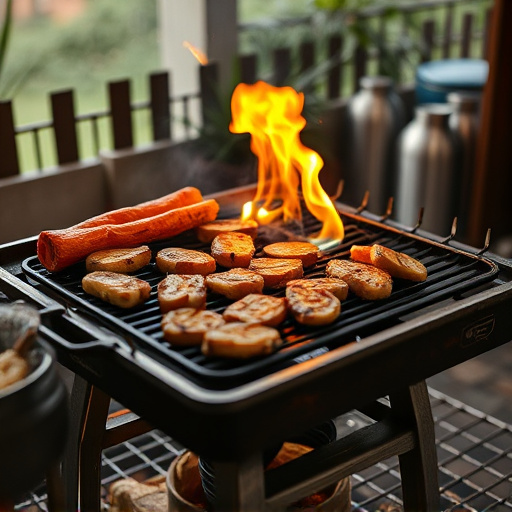Crafting the perfect Smoked BBQ Brisket Recipe involves selecting a high-quality, well-marbled brisket, applying a dry rub of salt, pepper, garlic powder, and paprika, and slowly smoking it at temperatures between 225°F to 250°F using premium hardwood pellets like oak or hickory. Achieve an internal temperature of around 165°F before wrapping, then serve with complementary sides like mashed potatoes, coleslaw, or cornbread to enhance its rich, smoky flavor. Experiment with wood chips for diverse taste profiles, ensuring a satisfying culinary experience.
Unleash the ultimate smoky flavor with our guide to crafting the perfect smoked BBQ brisket recipe. From understanding the cut’s characteristics to mastering the art of smoking, this comprehensive tutorial will transform you into a brisket master. We’ll walk you through essential ingredients, step-by-step techniques, and even the science behind wood choices for that authentic barbecue experience. Prepare to wow your crowd with a tender, flavorful brisket that’s sure to become a family favorite.
- Understanding Brisket: The Cut and Its Characteristics
- Essential Ingredients for a Memorable Smoked Brisket
- Step-by-Step Smoking Technique: From Prep to Perfection
- Mastering the Smoke: Types of Wood and Their Impact
- Servings and Side Dishes: Completing Your BBQ Brisket Experience
Understanding Brisket: The Cut and Its Characteristics
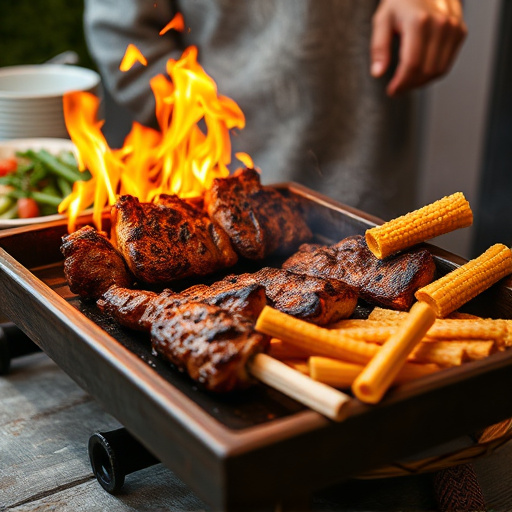
Brisket, a cut from the beef chest, is a true test for barbecue enthusiasts due to its unique characteristics. It’s a muscle with substantial marbling and fat content, making it ideal for slow-smoking techniques that transform it into a tender, flavorful delicacy known as smoked BBQ brisket recipe. The key to unlocking its potential lies in understanding its structure. Brisket has two distinct parts: the lean “first cut” or “flat,” and the fattier “second cut” or “point.” When preparing a smoked BBQ brisket recipe, both parts contribute to a rich, complex flavor profile.
The flat is leaner with more muscle fibers, requiring longer cooking times to break down. The point, with its higher fat content, renders during slow smoking, adding moisture and flavor. Mastery of temperature control and smoke management is essential in a smoked BBQ brisket recipe. This allows the fat to render evenly while gently tenderizing the lean meat, resulting in a perfectly balanced dish that celebrates the best of this versatile cut.
Essential Ingredients for a Memorable Smoked Brisket
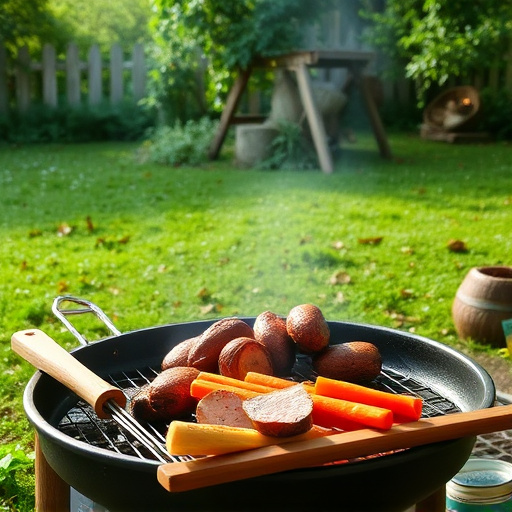
To achieve a truly exceptional smoked BBQ brisket recipe, certain key ingredients are essential. The foundation lies in a blend of rich, tender meat and a delicate smoke flavor that infuses every bite. Start with high-quality, well-marbled brisket, allowing it to rest at room temperature before cooking for optimal results. A simple dry rub composed of salt, pepper, garlic powder, and paprika not only adds depth but also helps to break down the meat’s collagen during the slow-cooking process, resulting in a melt-in-your-mouth texture.
For authentic smoky notes, invest in good quality hardwood pellets like oak or hickory. These pellets should complement rather than overpower the brisket’s natural flavor. A reliable smoker that maintains consistent temperature is crucial, allowing you to cook the meat slowly and evenly. Lastly, don’t underestimate the power of simple, time-honored techniques: slow cooking, patience, and a keen eye for detail will elevate your smoked BBQ brisket recipe to memorable status.
Step-by-Step Smoking Technique: From Prep to Perfection
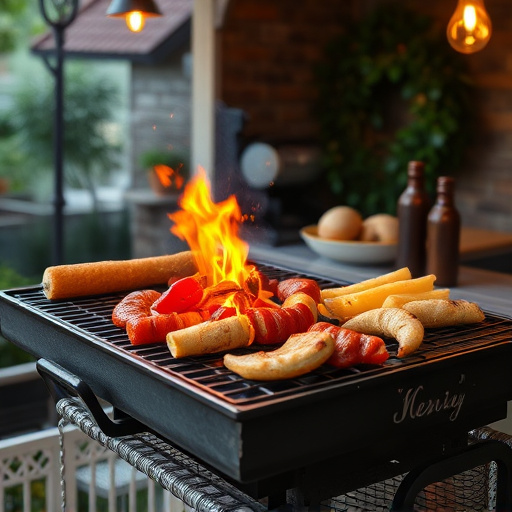
Step-by-Step Smoking Technique: From Prep to Perfection
To achieve the perfect smoked BBQ brisket recipe, preparation is key. Start by selecting a high-quality, well-marbled brisket. Trim excess fat to about 1/4 inch, leaving enough to keep the meat moist during the long smoking process. Next, apply a generous dry rub consisting of spices like paprika, garlic powder, salt, and pepper. This step infuses the brisket with flavor that will permeate every fiber as it smokes.
Smoke your brisket at a consistent low temperature—ideally between 225°F to 250°F (107°C to 121°C)—using your preferred wood chips or chunks. The slow and steady cooking method allows for even heat distribution, ensuring the interior reaches the ideal temperature without overcooking the exterior. Use a meat thermometer to monitor the internal temperature, aiming for around 165°F (74°C) before wrapping it in foil. This step-by-step smoking technique guarantees a smoky, tender, and flavorful brisket that will be the centerpiece of any gathering.
Mastering the Smoke: Types of Wood and Their Impact
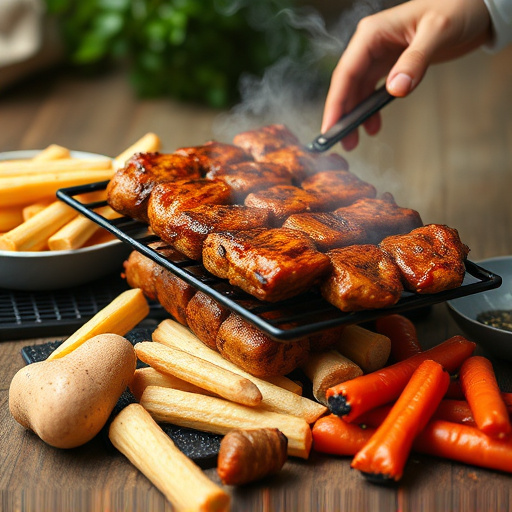
Mastering the smoke is an art that elevates any smoked BBQ brisket recipe to new heights. The type of wood chips or chunks used plays a pivotal role in infusing your meat with its distinct flavor profile. Different woods offer unique aromas and tastes, ensuring each bite transports you to a specific place—be it a cozy campfire or a lush forest. For a classic, robust smoke, hickory is a popular choice, imparting a rich, slightly sweet taste that complements the fatty brisket. Apple wood chips contribute a milder, fruity note, resulting in a cleaner, more subtle smoke flavor. Mesquite, with its intense, pungent aroma, adds a bold kick to your BBQ brisket, perfect for those who prefer a stronger, more distinctive smoky taste.
Understanding how different woods interact with the cooking process is key. Hardwoods like hickory and mesquite burn longer, creating sustained heat that gently cooks the brisket, while softer woods like apple chips produce faster-igniting flames, requiring careful management to avoid burning the meat. Experimenting with these varieties allows you to craft a smoked BBQ brisket recipe tailored to your preference, ensuring each mouthful is an unforgettable experience for your taste buds.
Servings and Side Dishes: Completing Your BBQ Brisket Experience
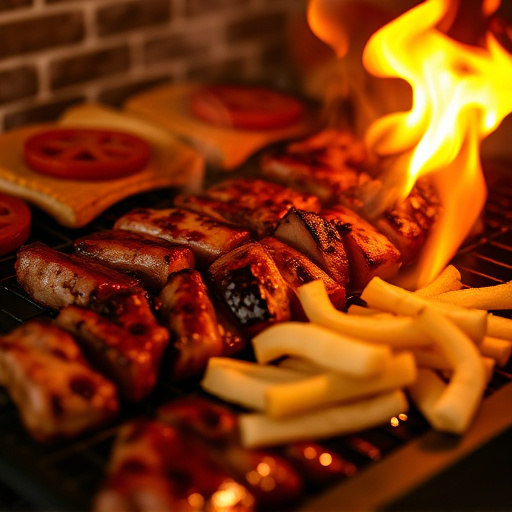
When it comes to a Smoked BBQ Brisket Recipe, the key is to serve it with sides that complement its rich, smoky flavor. A classic pairing is creamy mashed potatoes or coleslaw, which offer a refreshing crunch. For a more robust meal, consider adding baked beans, cornbread, or even grilled vegetables like asparagus or zucchini. These side dishes not only complete your BBQ brisket experience but also enhance the overall dining pleasure, making it a true celebration of smoky, tender meat.
Remember, the best BBQ Brisket Recipe is one that’s tailored to personal preference. Whether you prefer your brisket with a generous helping of sauce or simply seasoned to highlight its natural juices, the choice is yours. The goal is to create a balanced meal that leaves your guests satisfied and eager for more, making it the perfect centerpiece for any gathering.
